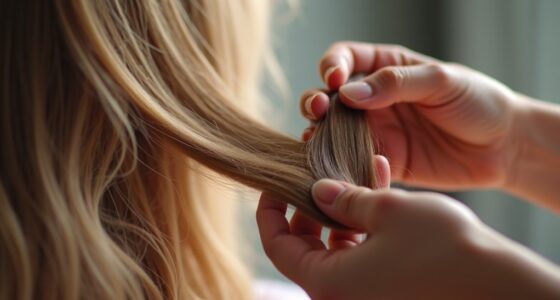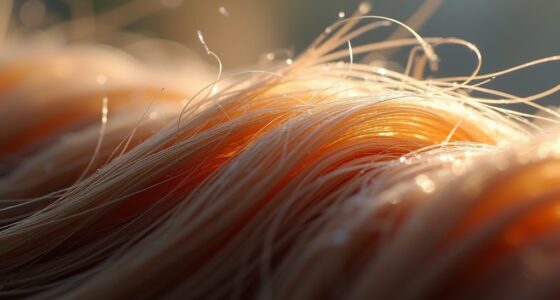How often you should shampoo depends on your hair and scalp type, lifestyle, and product use. Oily scalps or active lifestyles may need washing every other day, while dry or curly hair benefits from weekly washes. Over-shampooing can strip natural oils, causing dryness or irritation, while infrequent washing might lead to buildup. Understanding your unique needs helps maintain healthy, balanced hair—if you want to learn how to customize your routine, keep exploring.
Key Takeaways
- Shampoo frequency depends on scalp oil production; oily scalps may need daily washing, while dry scalps benefit from less frequent cleansing.
- Over-washing can strip natural oils, leading to dryness and increased sebum production, which can worsen oiliness.
- Gentle, sulfate-free shampoos help preserve moisture and color, especially for dyed or sensitive scalps.
- Personal factors like hair type, styling habits, and environmental exposure should guide individualized shampoo routines.
- Maintaining a balanced pH and using scalp-friendly products supports healthy sebum regulation and overall scalp health.
Understanding Your Hair and Scalp Type
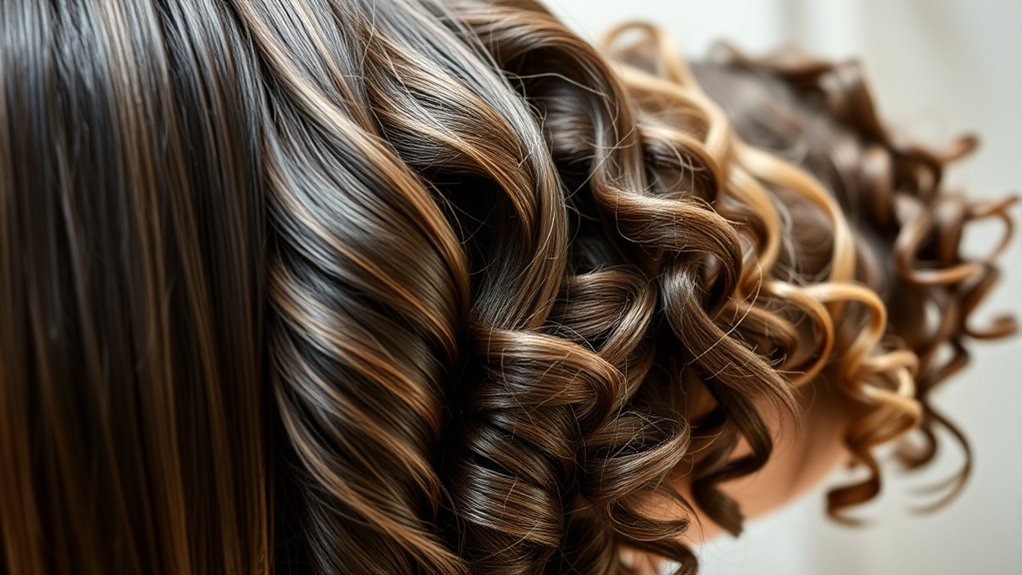
Understanding your hair and scalp type is essential for establishing an effective shampooing routine. If you’ve dyed your hair, you’ll want a gentle shampoo that preserves color while preventing dryness. For those with scalp psoriasis, choosing a medicated or soothing shampoo helps manage irritation and flaking. Your scalp’s oil production also influences how often you should wash—oily scalps may need more frequent washing, while dry scalps benefit from less. Recognizing whether your hair is fine, thick, straight, or curly helps determine the right shampoo formulation and frequency. Additionally, understanding hair porosity can further refine your hair care routine by indicating how well your hair absorbs and retains moisture. Properly assessing your scalp condition is crucial for selecting the most suitable products and washing schedule. Regularly assessing your scalp condition can help you optimize your hair care routine for better results. Being aware of seasonal changes in climate can also influence how often you should shampoo, as humidity and temperature affect scalp health and oil production. This approach guarantees ideal hair health and scalp comfort.
The Science Behind Sebum Production and Hair Health
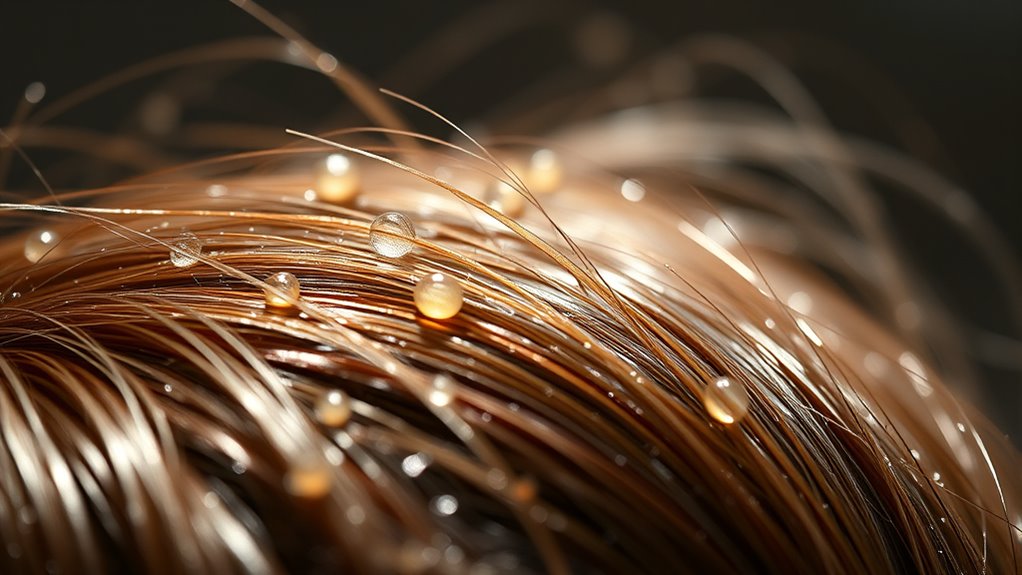
Your scalp’s sebaceous glands control sebum production, which keeps your hair moisturized and protected. Factors like hormones, diet, and hygiene influence how much sebum you produce, affecting your hair’s health and appearance. Understanding these processes helps you find the right shampooing routine for your hair type. For example, Water Parks in various locations often emphasize the importance of hydration and cleanliness, paralleling the need to maintain a balanced scalp. Maintaining a healthy scalp also involves managing sleep and stress, which can influence sebum levels and overall hair health. Incorporating protective styles, such as crochet locs, can also support scalp health by reducing manipulation and breakage.
Sebaceous Gland Functionality
Sebaceous glands are tiny but essential structures in your scalp that produce sebum, an oily substance indispensable for maintaining hair health. Sebum helps keep your scalp hydrated, preventing dryness and flakiness, and influences hair porosity, affecting how your hair absorbs moisture. When these glands function at their best, they balance oil production, supporting strong, healthy hair. Overactive glands can lead to greasy roots, while underactive ones cause dryness and brittle strands. Understanding how your sebaceous glands operate helps you tailor your shampoo routine to your scalp’s needs. Here’s a quick look at sebum’s role: Eye Patch Benefits Balancing sebum ensures your hair maintains ideal hydration and porosity.
Factors Influencing Sebum
The amount of sebum your scalp produces is influenced by a variety of factors, from genetics to environmental conditions. Your scalp hydration plays a vital role; well-hydrated skin tends to regulate sebum production better, reducing excess oil. Conversely, dry or dehydrated scalp can signal your skin to produce more sebum to compensate. Hair porosity also affects sebum levels—high-porosity hair absorbs oils quickly, often prompting your scalp to produce more sebum to maintain balance. External factors, like climate and pollution, further impact sebum production by either stripping moisture or triggering oil overproduction. Additionally, the use of air purifiers in your environment can help reduce airborne pollutants that may irritate your scalp and influence sebum secretion. Incorporating AI-driven air quality monitoring can provide real-time insights into environmental conditions that affect your scalp health. Maintaining a balanced scalp environment involves not only proper hair care but also managing environmental pollutants, which can significantly impact sebum levels and overall scalp health. Understanding these influences can help you tailor your hair care routine, ensuring your scalp remains balanced and healthy without overproducing or underproducing sebum.
Impact on Hair Condition
Since sebum plays a crucial role in maintaining hair health, understanding how it affects your strands is essential. Proper sebum levels keep your scalp moisturized, shiny hair, and reduce breakage. Over-washing can strip sebum, leading to dryness and irritation, especially if you’ve recently dyed your hair, which weakens strands. Conversely, infrequent washing allows excess sebum to build up, causing greasy roots and dullness. Regular scalp massages boost sebum distribution, promoting healthier hair.
| Effect of Sebum on Hair | Result |
|---|---|
| Balanced production | Soft, shiny, healthy hair |
| Excess sebum | Greasy scalp, dull appearance |
| Sebum deficiency | Dry, brittle, prone to breakage |
| Hair dyeing | Can dry out scalp, affect sebum balance |
| Scalp massages | Improve circulation, sebum distribution |
How Frequent Washing Affects Your Hair’s Natural Barrier
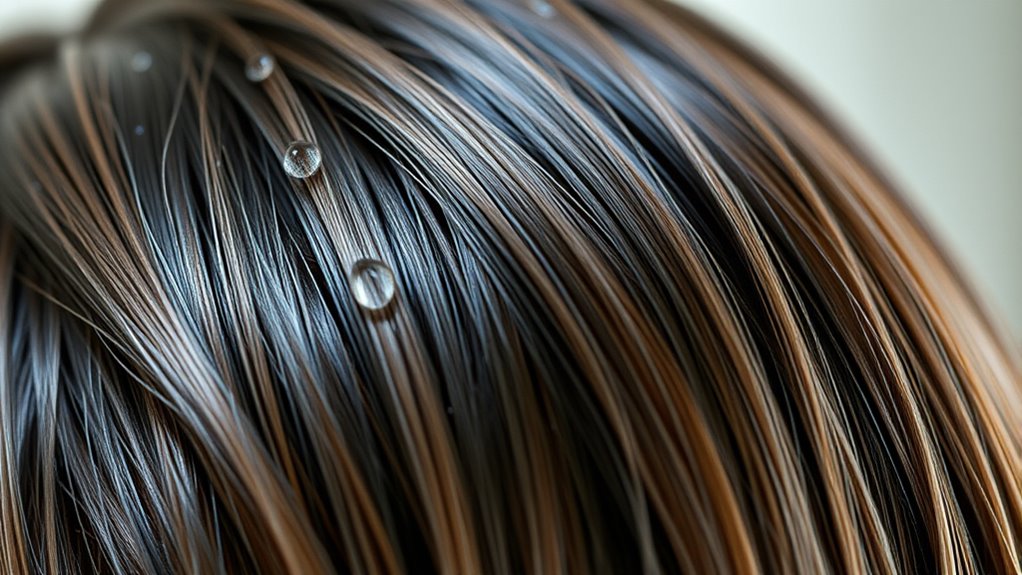
Washing your hair too often can disrupt the natural sebum layer that protects your scalp. This can lead to a higher scalp pH, causing irritation and dryness. Understanding how frequent washing impacts this delicate balance helps you make better hair care choices. Over-washing may also strip away essential oils, leading to increased oil production as your scalp tries to compensate, which can further exacerbate the problem Sebum Layer. Additionally, frequent washing can interfere with the skin’s microbiome, potentially leading to imbalances that affect scalp health. Incorporating sound healing science perspectives on maintaining harmony can provide a holistic approach to scalp care.
Disruption of Sebum Layer
Frequent shampooing can disrupt your hair’s natural sebum layer, which acts as a protective barrier against environmental damage and dryness. When you wash too often, you strip away this essential oil, leading to decreased scalp hydration. Without enough sebum, your scalp becomes more vulnerable to irritation and dryness, and your hair’s porosity increases, making it absorb moisture and chemicals more easily. This can result in hair that feels brittle, straw-like, or overly porous. Maintaining a balanced washing routine helps preserve the sebum layer, supporting healthy scalp hydration and keeping your hair’s natural moisture barrier intact. Proper hair care practices, including understanding vetted shampooing routines, are crucial for maintaining optimal hair health and appearance. Additionally, understanding scalp health can help you tailor your washing frequency to support long-term hair integrity. Being aware of hair porosity can guide you in choosing appropriate hair care products and routines to protect your hair’s structure. Recognizing the importance of sebaceous glands in producing sebum can further inform your hair care decisions and routines.
Impact on Scalp Ph
Regularly cleaning your scalp can alter its natural pH balance, which is essential for maintaining healthy hair and skin. When you wash too often, you may disrupt the scalp’s acidity, leading to decreased scalp hydration and increased hair porosity. A balanced pH helps protect the scalp’s barrier, preventing dryness and irritation. If the pH becomes too alkaline, your hair cuticles can lift, making your hair more prone to damage and moisture loss. Conversely, infrequent washing can cause buildup, affecting scalp health and hydration. Maintaining the right pH level supports ideal scalp conditions, which in turn preserves your hair’s strength, shine, and resilience. Proper exfoliation with gentle ingredients can help prevent buildup and maintain a healthy scalp environment. Additionally, understanding the scalp’s natural pH can guide you in choosing the right hair care products to support your scalp’s health. Understanding this balance helps you choose a washing frequency that supports your hair’s natural barrier and overall health. Scalp health is closely linked to the skin’s ability to defend against environmental stressors and microbial invasion.
The Impact of Shampoo Ingredients on Hair and Scalp
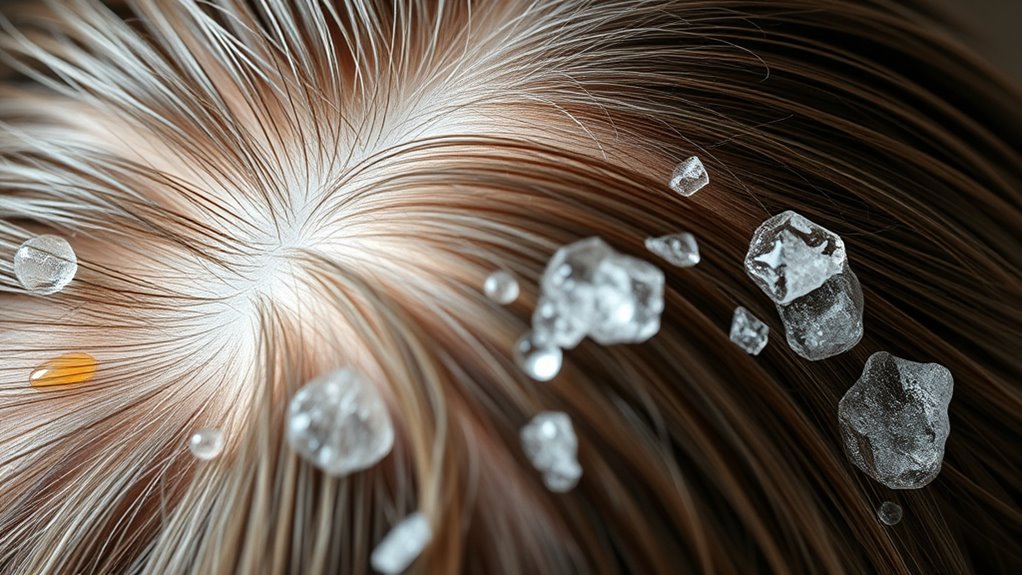
The ingredients in your shampoo directly influence the health of your hair and scalp. Harmful chemicals like certain chemical preservatives can cause dryness or irritation, especially if you have sensitive skin. Fragrance sensitivities are common, and artificial scents may trigger discomfort or allergic reactions. Some ingredients strip natural oils, leading to brittle hair, while others nourish and strengthen. Pay attention to labels and choose shampoos with gentle, natural components if you notice scalp itchiness or hair damage. Here’s a quick comparison:
| Ingredient Type | Effect on Hair/Scalp |
|---|---|
| Chemical preservatives | Might cause irritation or dryness |
| Fragrance additives | Can trigger sensitivities or allergies |
| Sulfates | Strips natural oils, dries hair |
| Natural oils | Moisturize and strengthen hair |
| Parabens | Potential hormone disruptors |
Recommended Shampooing Frequencies for Different Hair Types
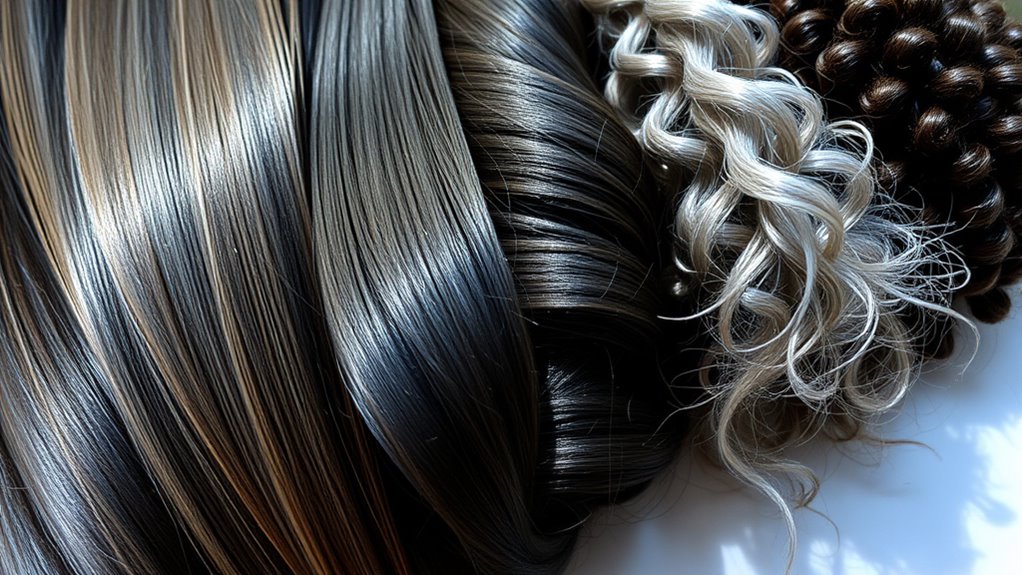
Choosing the right shampooing frequency depends on your hair type and scalp condition. If you have oily scalp or fine hair, you might need to shampoo more often, around every other day, to prevent buildup and maintain freshness. For those with dry or curly hair, washing once a week or less helps retain natural oils and prevent scalp irritation. If you have color-treated hair, less frequent washing preserves your hair color longer and minimizes fading. Over-shampooing can strip oils, leading to dryness and irritation, especially for sensitive scalps. Conversely, washing too infrequently can cause scalp irritation from excess oil and buildup. Adjust your routine based on how your scalp responds, ensuring you balance cleanliness with scalp health and hair color preservation.
Personalizing Your Routine: Factors to Consider
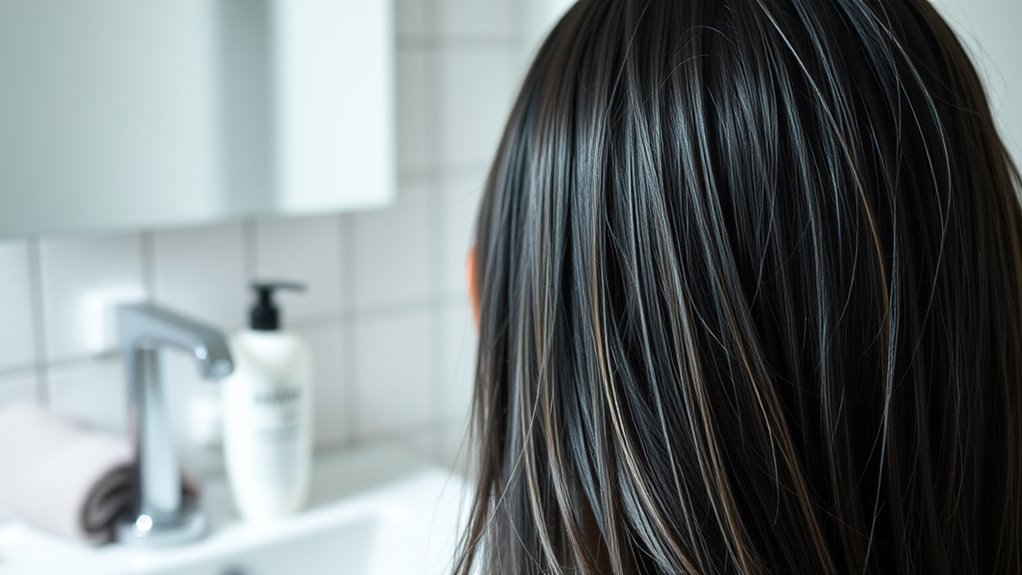
To personalize your shampooing routine effectively, you need to contemplate several key factors that influence your hair and scalp health. Hair dyeing can strip natural oils, making your scalp more sensitive and requiring gentler cleansing or less frequent washes. Styling products like gels, sprays, or waxes build up on your hair and scalp, potentially necessitating more regular washing to prevent residue buildup. Consider how often you use these products and whether your hair feels greasy or weighed down afterward. Additionally, your hair’s texture and scalp condition play roles—oily scalps may need more frequent washes, while dry or color-treated hair benefits from gentler, less frequent shampooing. Adjusting based on these factors helps maintain healthy, balanced hair tailored specifically to your needs.
Tips for Maintaining Hair Health Between Washes

Maintaining hair health between washes is essential to keep your hair looking fresh and minimize damage. To protect your hair dye, avoid excessive washing that can fade color quickly. When you do wash, use sulfate-free shampoos to preserve vibrancy. Minimize heat styling, as frequent use of heat tools weakens hair strands and causes breakage. Before heat styling, always apply a heat protectant to reduce damage. Incorporate dry shampoos or scalp refreshers between washes to absorb excess oil and keep your hair looking clean. Regularly detangle gently to prevent breakage, especially if your hair is color-treated or heat-styled often. Staying mindful of these tips helps maintain your hair’s health, color, and shine longer between washes.
Frequently Asked Questions
Can Washing Hair Too Often Cause Scalp Infections?
Washing your hair too often can lead to scalp irritation, which may increase the risk of scalp infections. Frequent washing strips away natural oils, causing the scalp to become dry and inflamed. This irritation can promote bacterial growth, making infections more likely. To prevent this, find a balance that keeps your scalp clean without overdoing it, and use gentle shampoos that support healthy scalp conditions.
How Does Shampooing Frequency Affect Hair Color Preservation?
Imagine your hair as a delicate painting, where every wash risks fading its vibrant hues. Shampooing too often can strip away color, causing hair dye fading and shortening color longevity. To keep your color looking fresh longer, wash less frequently with gentle, sulfate-free shampoos. This way, you preserve your hair’s true vibrancy, letting your hair’s beauty shine through as an enduring masterpiece, not a fleeting impression.
Are There Specific Signs Indicating I Should Wash My Hair More or Less?
If you notice excessive hair oil buildup or scalp itchiness, it’s a sign you should wash your hair more often. Conversely, if your hair feels dry or brittle, you might need to shampoo less. Pay attention to how your scalp reacts and adjust your routine accordingly. Regularly balancing your washing frequency helps keep your scalp healthy and prevents issues like buildup or dryness.
Does Water Temperature Influence Scalp Health During Shampooing?
When it comes to water temperature and scalp health, you’re playing with fire if you go too hot or cold. Warm water is your best bet because it helps open hair cuticles and loosen dirt without irritating your scalp. Hot water can strip natural oils, leading to dryness, while cold water might not clean thoroughly. Stick to lukewarm, and you’ll keep your scalp healthy and happy.
Can Shampooing Frequency Impact Hair Growth Rates?
Shampooing frequency can influence your hair growth, especially if you have specific hair texture or scalp dryness. Washing too often might strip natural oils, leading to scalp dryness and slower growth. Conversely, infrequent washing can cause buildup, affecting hair health. Find a balanced routine tailored to your hair texture, and you’ll support a healthy scalp and promote ideal hair growth. Pay attention to how your scalp responds and adjust accordingly.
Conclusion
Ultimately, finding your perfect shampooing schedule depends on understanding your hair and scalp needs. Are you listening to your hair’s signals and adjusting accordingly? Remember, there’s no one-size-fits-all answer—your routine should support healthy hair without stripping away its natural defenses. By paying attention and experimenting thoughtfully, you can keep your hair vibrant and balanced. Isn’t caring for your hair a reflection of how well you know yourself?




